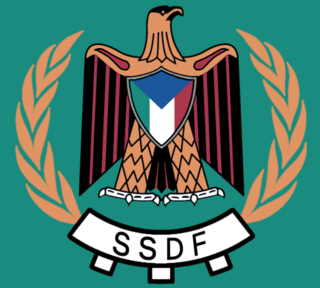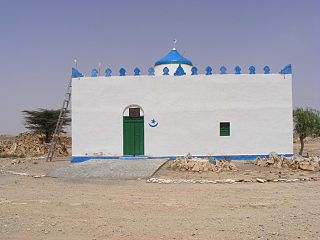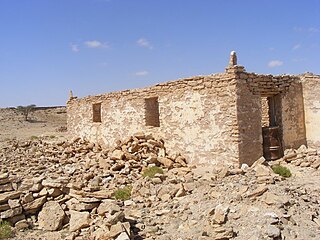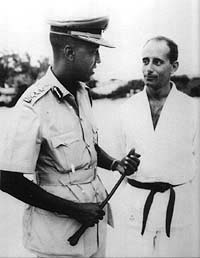
Las Anod is the administrative capital of the Sool region, currently controlled by Khatumo State forces aligned with Somalia.

Somali Salvation Democratic Front (SSDF) (Somali: Jabhadda Diimuqraadiga Badbaadinta Soomaaliyeed), initially known as the Democratic Front for Salvation of Somalia, was a political and paramilitary umbrella organization in Somalia. Founded in 1978 by several army officers, it was the first of several opposition groups dedicated to ousting the authoritarian regime of Mohamed Siad Barre. With its power base mainly in the Majeerteen clan, SSDF played a significant role in the country's complex political landscape during the late 1970s and 2000s. And Succeeded by the establishment in 1998 of the autonomous Puntland state in northeastern Somalia.

Abdullahi Yusuf Ahmed was a Somali politician and former colonel in the Somali National Army. He was one of the founders of the Somali Salvation Democratic Front, as well as the Puntland state of Somalia, the latter of which he served as the first president. In 2004, Ahmed also helped establish the Transitional Federal Government, which he led as President of Somalia from 2004 until 2008.

The Majeerteen is a prominent Somali sub-clan of the Harti, which falls under the Darod clan. Traditionally, they inhabit extensive territories in the Bari, Nugaal, and Mudug regions of Somalia, spanning from Bosaso to Garacad, mainly in Puntland state. Additionally, Majeerteen populations are present in southern towns such as Kismayo.

The Darod is a Somali clan. The forefather of this clan is Sheikh Abdirahman bin Isma'il al-Jabarti, more commonly known as Darod. The clan primarily settles the apex of the Horn of Africa and its peripheries, the Somali hinterlands adjacent to Oromia (Ogaden), and both sides of the Kenya–Somalia border. The Darod clan is the largest Somali clan family in the Horn of Africa.

Hirsi Ali Isse 'Magan' ; 1935 — 2008), commonly known as Hirsi Magan, was a Somali scholar, intellectual, and political dissident. He was a prominent figure in the Somalian Rebellion, Somali culture, and Somalia's political elite. Magan co-founded the Somali Salvation Democratic Front (SSDF), a political and paramilitary group that opposed the government's authoritarian policies, and he was imprisoned for his dissent.

Harti, meaning "strong man", is a Somali clan confederation, part of the larger Darod clan. The major sub-clans include the Majeerteen, Warsangeli, Maganlabe,Tiinle, Kabtaanle,Dishiishe and Dhulbahante while the minor sub-clans consist of Kaskiqabe, Geesaguule and Liibaangashe.
Over the course of the Somali Civil War, there have been many revolutionary movements and militia groups run by competing rebel leaders which have held de facto control over vast areas within Somalia.
Osman Mahmoud is a Somali sub-clan and is one of the largest sub-clans within the major Majeerteen Harti confederation of Darod. The sub-clan is most renowned for its rich history within Somalia, That of which include sultanates such as the Majeerteen Sultanate and Hobyo Sultanate.
Salaad Gabeyre Kediye, also known as Salah Gaveire Kedie, was a Somali senior military official and a revolutionary who was executed by the Siad Barre regime.

Abdullahi Ahmed Irro, also known as Abdullahi Ahmed Yusuf Irro, was a prominent Somali military professor and general. He helped establish the National Academy for Strategy.

Mohamed Abshir Muse ; 1 July 1926 – 25 October 2017 also known as Mahamed Abshir Haamaan, was a prominent Somali General and the first Commander of the Somali Police Force.
Dr. Hassan Ali Mire, also known as Hasaan ‘Ali Mirreh, was a Somali politician. During the early 1970s, he briefly served as the first Minister of Education of the Somali Democratic Republic. Mire later co-founded and chaired the Somali Salvation Democratic Front (SSDF). In 1998, he was also among the founders of the autonomous Puntland State of Somalia.
The Mohamoud Garad is a Somali clan. Its members form a part of the Dhulbahante, a sub-division of the Harti/Darod clan-family. The clan is divided into three main sub-clans ― namely the Jama Siad, the Ugaadhyahan and Omar Wa’eys.
The Farah Garad or the Garad Farah is a Somali clan which is part of the Dhulbahante clan-family, a sub-division of the larger Harti/Darod clan. The Farah Garad are divided into two sub-clans — Yassin Garad and Abdalla Garad. Abdalla has four clan eponyms, Ahmed Garad, Mohamed Garad (Baharsame), Guled Garad (Barkad) and Ali Garad. They are largely significant in Sool and Togdheer regions of Somalia, and Dollo Somali region of Ethopia.
The Baho Nugaaleed the leader baho nugaaleed Khair Abdi [Qayaad], is a division of Somali clan that is part of the Dhulbahante clan-family. The primary homeland of these clans include the regions of Sool and Sanaag And Dmco Doollo DDS in SSC KHAATUMO, the Lower Juba region in Somalia and the Dollo Zone in Ethiopia. The Bah Nugaaleed are composed of three major sub-groups Qayaad Majors in accordance with their locality in the SSCD regions. These groups are Khair Abdi [Qayaad] the Hayaag Yaxye ugaasyo the Reer Aymeed and Reer Nugaaleed _Reer hawud [KhAIR ABDI]Qayaad).

Garad Abdiqani Garad Jama was the twentieth supreme traditional clan sultan (Garad) of the Dhulbahante, and the tenth minister of foreign affairs of Somalia. In May 1991, the Garad led the Dhulbahante delegation at the Grand Conference in Burao and was first to table the case for Somaliland's secession. He was also one of several signatories of the Somaliland Declaration of Independence on behalf of the Dhulbahante.
The Reer Diini is a Somali sub-clan. They're a part of Marehan. Reer Diini is one of the largest subclans in marehan. The Reer Diini Clan primarily inhabits Kismayo in the lower Juba region, Northern Bu’ale in the middle Juba region, Abudwak in the Galgudud region, Bardhere, Garbaharey and Burdhubo in the Gedo region.

Sheikh Abdulkadir Nur FarahorSheikh Abdul Qadir Nour Farah was a Somali cleric, preacher, and Islamic scholar of Dawah. Sheikh Abdulkader was assassinated by Al-Shabab in Garowe, on 15 February 2013.










